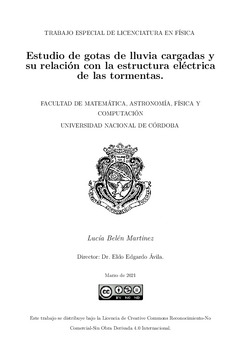| dc.contributor.advisor | Ávila, Eldo Edgardo | |
| dc.contributor.author | Martinez, Lucía Belén | |
| dc.date.accessioned | 2021-04-12T21:22:01Z | |
| dc.date.available | 2021-04-12T21:22:01Z | |
| dc.date.issued | 2021 | |
| dc.identifier.uri | http://hdl.handle.net/11086/17680 | |
| dc.description | Tesis (Lic. en Física)--Universidad Nacional de Córdoba, Facultad de Matemática, Astronomía, Física y Computación, 2021. | es |
| dc.description.abstract | El objetivo de este trabajo es el de determinar los tamaños y las cargas eléctricas que transportan las partículas de precipitación (PP) y estudiar la evolución temporal de las mismas durante las tormentas mediante un estudio experimental de campo de gotas de precipitación cargadas. Se realizan mediciones en superficie de la velocidad de caída (V) y carga eléctrica (Q) de gotas de lluvia individuales de 4 tormentas distintas, ocurridas en Córdoba Capital en los años 2018 y 2019. Con los datos de V es posible determinar los tamaños (D) de cada una de las gotas medidas (Pruppacher & Klett 1997). Se analizará la evolución temporal de Q y D de las PP, la correlación entre Q y D para gotas con cargas positivas y negativas, la distribución de tamaños de partículas cargadas y distribución de tamaños de gotas de lluvia totales. Se utilizó el instrumento para medir cargas de FaMAF (GFA) como así datos de disdrómetro de la NASA, de radar, satélite y de la red Lightning Mapping Array (LMA). | es |
| dc.description.abstract | The objective of this work is to determine the size and electrical charge of the precipitation particles (PP) and to study their temporal evolution during storms by an experimental field study of charged precipitation droplets. Surface measurements of the fall rate (V) and electric charge (Q) of individual raindrops from 4 different storms, which occurred in Córdoba Capital in 2018 and 2019 were made for this purpose. With the V data it is possible to determine the size (D) of each of the measured drops (Pruppacher & Klett 1997). The information obtained in the different storms will allow the analysis of the following factors: the temporal evolution of Q and D of the PP, the correlation between Q and D for both positively and negatively charged drops, the size distribution of charged particles and the size distribution of total raindrops. A charge measuring instrument is used to perform these measurements added to data from the disdrometer of NASA, data from radar, satellite and the Lightning Mapping Array (LMA) network. | en |
| dc.language.iso | spa | es |
| dc.rights | Attribution-NonCommercial-NoDerivatives 4.0 Internacional | * |
| dc.rights.uri | http://creativecommons.org/licenses/by-nc-nd/4.0/ | * |
| dc.subject | Gotas de lluvia cargadas | es |
| dc.subject | Tormenta | es |
| dc.subject | Distribución de tamaños | es |
| dc.subject | Evolución temporal | es |
| dc.subject | Teoría no-inductiva | es |
| dc.subject | Atmospheric Science | en |
| dc.title | Estudio de gotas de lluvia cargadas y su relación con la estructura eléctrica de las tormentas | es |
| dc.type | bachelorThesis | es |
| dc.description.version | publishedVersion | |
| dc.description.fil | Fil: Martinez, Lucía Belén. Universidad Nacional de Córdoba. Facultad de Matemática, Astronomía, Física y Computación; Argentina. | es |





